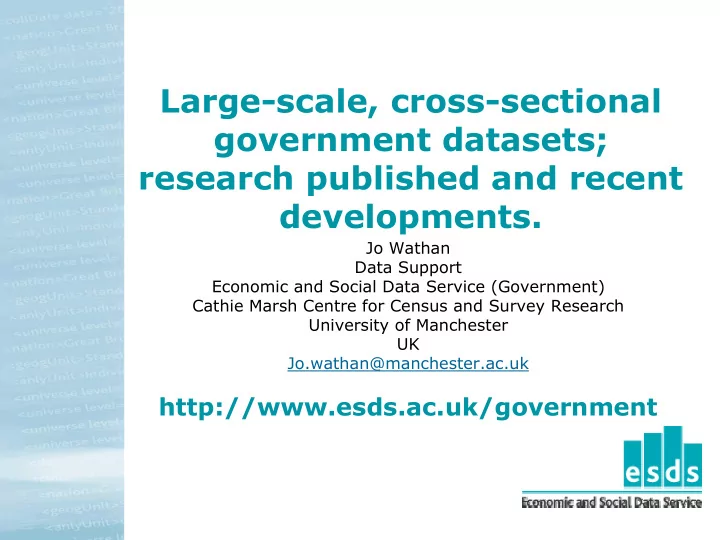

Large-scale, cross-sectional government datasets; research published and recent developments. Jo Wathan Data Support Economic and Social Data Service (Government) Cathie Marsh Centre for Census and Survey Research University of Manchester UK Jo.wathan@manchester.ac.uk http://www.esds.ac.uk/government
ESDS Government • Economic and Social Data Service is the leading data dissemination and support service for social data in the UK. Started Jan ‘03 • Distributed service, involving 4 organisations at 2 sites in the UK • ESDS Government is one of 4 specialist services. It deals with large-scale cross-sectional continuous surveys – Academic service funded by Economic and Social Research Council – Data archiving and dissemination done by the UK Data Archive (download/Nesstar) – User support and outreach done by the Centre for Census and Survey Research – Data comes from the Office for National Statistics or National Centre for Social Research
Which surveys? • General Household Survey • Labour Force Survey • Family Resources Survey • Expenditure and Food Survey (previously the National Food Survey and Family Expenditure Survey) • ONS Omnibus Survey • National Travel Survey • Time Use Survey • British Crime Survey/Scottish Crime Survey • British Social Attitudes/Scottish Social Attitudes/Northern Ireland Life & Times/Young People’s Social Attitudes • Health Survey for England/Wales/Scotland • Survey of English Housing (England only)
What is the data like? • Survey microdata • Large sample sizes (but smaller than the SARs) • Continuous surveys – always up-to-date • Cross-sectional (although the LFS has a 5- quarter panel element, GHS goes longitudinal this year) • Specialist topic surveys – more depth than the Census • Freely available to academics via ESDS
Increased data use: Jan 02-now (ESDS started Jan 03) 10000 9000 8000 Other 7000 FES/NFS/EFS 6000 5000 BCS 4000 HSE 3000 2000 GHS 1000 LFS 0 2002(1) 2002(2) 2003(1) 2003(2) 2004(1) 2004(2)
How are the data used? To provide nationally representative results, with the flexibility of microdata: • Analyses looking at change over time – Repeated cross-sections – Pseudo-cohort studies • To look at sub-populations – Large sample sizes – Many datasets can be pooled due to relative consistency in content and method over time • Hierarchical data for household analyses • To provide users with the scope to operationalise concepts differently and use more sophisticated modelling
Change over time • Data well suited – emphasis SMOKING AND SOCIAL CLASS - MEN on stability and comparability 45 • Straightforward trends; e.g. 40 – Smoking by class (Marmot 35 2003) 30 25 – Smoking prevalence by month % 20 (Jarvis 2003) 15 – Attitudes to homosexuality 10 (Crocket and Voas 2003) 5 • Pseudo cohort analyses 0 1994 1995 1996 1997 1998 1999 2000 2001 – Women’s access to pensions by partnership (Ginn 2003) year – Alcohol consumption by age Source:HSE all sc I&II sc IV&V (Kemm 2003) – Changing risk factors for divorce by year of marriage (Chan & Halpin 2005)
Representative samples of subpopulations • Samples vary but can be large: – Labour Force Survey: c.60k households – Family Resources survey: c.27k households – British Crime Survey: c. 33k individuals • Pool to increase sample size of small subpopulations – e.g. individual ethnic groups – 12 years pooled of LFS to look at women’s employment by ethnic group (Dale et. Al 2005) – 3 years of FRS to look at women’s pension chances by ethnic group (Ginn and Arber 2001) • Health Survey contains subgroup boosts – 1999 Ethnic minority boost allow analysis of obesity by ethnic group (Saxena et. Al. 2004)
Using hierarchy to look within households • Workless Household ID Household type Households (Dickens et.al, 2000) Person 1 Person 2 Person 3 • Educational 40 years 42 14 Female Male Male homogamy in Working Unemployed Student Britain & Ireland Workless households (source FES, various years (Halpin 2003) 1968-1996) • Impact of 25 parenthood/ Percentage (of present partnership 20 working age hoh) workless households 15 children in workless 10 households 5 0 68 70 72 74 76 78 80 82 84 86 88 90 92 94 96 Year
ESDS Government Outreach and Support • Help-desk • User Groups • Annual Research Conference • Newsletter • Vital stats GIS interface • Interface between Government and Users • Themed materials and training – Training workshops and publicity events – Production of teaching datasets – Web-based materials
Workshop and Events Introductory workshops (inc. those joint with SARs workshops) Joint workshops with other ESDS services Methods Research conferences Dataset user groups Other presentations Posters
Data - value added • Annual teaching dataset produced – With documentation – Based around annual theme • Information about comparing data over time – Derived variables produced where necessary – User-generated derived variables QAd and made available
Resources to support users • Thematic Guides • FAQs & Starting Analysis Guides • Methodological Guides – SPSS, Stata – Guide to weighting • Publications database • Biannual newsletter • Links to other web resources
CommonGIS Interface for Vital Statistics
Help-desk • 174 Queries in the last year • Range of different ranges of complexity: – How do I get access to the HSE? – What are social classes written as roman numerals? – Why do my sample sizes increase if I weight? – Should I apply weights if I’m modelling? – The sample size for matched LFS data seem wrong – The household identifiers are missing from an early LFS • Help desk involves collaboration with UKDA and ONS
Interface between data depositors and users • Organise User Groups for data producers to meet users • Awareness and consultation role in developments – General Household Survey (Longitudinal) – Continuous Population Survey • Data access e.g. Special Conditions – Response to increased concern about confidentiality and withdrawal of some data – Negotiation of tighter conditions to permit access to data which poses greater confidentiality concerns – Access to information on date of birth, local authority district etc.
Recommend
More recommend